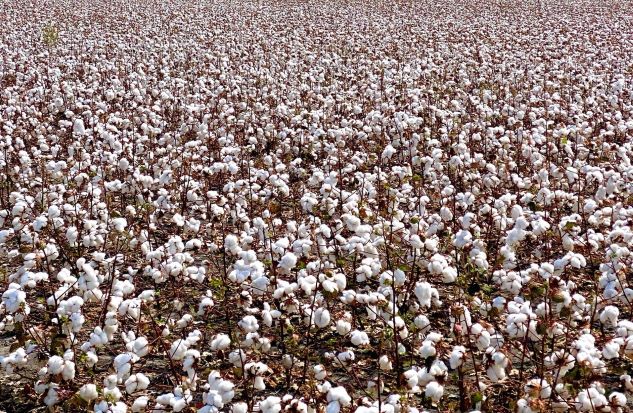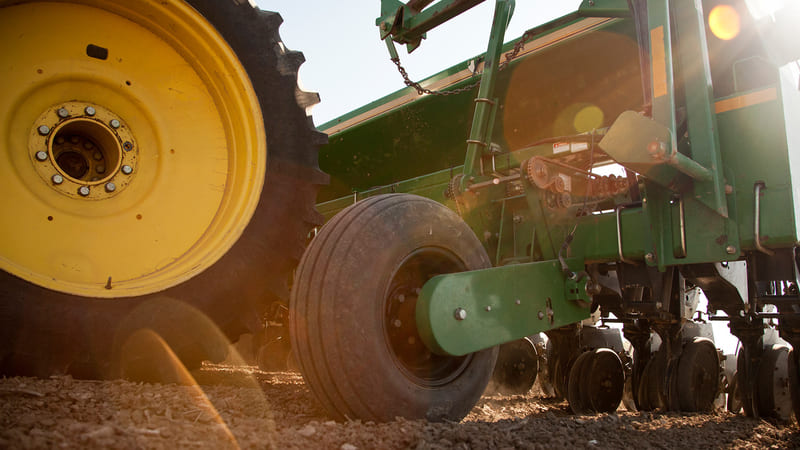High Cotton Prices Attractive for 2022 Dryland Acres
Photo: Larry Stalcup
With prices still in the dynamite dollar per pound or more range for 2022 cotton, dryland growers hope to carry that market to strong profits like many enjoyed in 2021.
But faced with high input costs, including skyrocketing fertilizer and increased chemical, fuel, seed and prices, growers need to make better use of the management tools available to help prevent deep cuts into profit, says Dr. Jourdan Bell, Texas A&M AgriLife Extension agronomist in Amarillo.
Like heading into the new year, producers had a poor start on cotton in 2021. Drought was parching much of West Texas that was lingering in a La Nina dry weather pattern. “People planned on more water tolerant and drought-tolerant crops,” Bell says. “But then it started raining in April in many areas. Attitudes changed. However, cool weather delayed cotton planting for many.”
While numerous dryland fields yielded 1.5 to 2 bales/A, late summer dry weather stunted late growth in others. Some Panhandle area yields didn’t yield over 200 to 500 lbs./A.
“However, gin turnout was good,” Bell says. “Turnouts were 30% to 34% in many areas. We also saw good quality lint, with loan values in the 54- to 56-cent range.”
Precise Soil Sampling
Good quality numbers and the dollar price are still attracting more acres. Dryland cotton will typically produce more per acre than dryland sorghum, even with higher grain prices. But soil sampling will see added importance for 2022 to hopefully offset record fertilizer costs. The American Farm Bureau Federation reports that compared to September 2020 prices, ammonia has increased over 210% and liquid nitrogen has increased over 159%.
Additionally, Urea is up 155%, monoammonium phosphate (MAP) has increased 125%, diammonium phosphate (DAP) is up over 100%, and potash has risen above 134%. And those prices continue to increase due to world supply chain issues, higher energy costs and higher world demand.
“There will be much value in soil sampling to have a clearer idea of what the crop needs,” Bell notes. “Those who don’t take soil samples often apply fertilizer when it isn’t needed. Over applying typically reduces profitability.”
She suggested taking a deeper soil sample. “If you can, sample two to three feet deep. If that’s not possible, dig down a foot or more,” she explains. “That will yield more information than a 6-inch sample.”
Availability of fertilizer is an issue. Bell says many growers are concerned about fertilizer – “not just booking it but having to go pick it up as well.”
Rely on Residue
Crop rotation remains important, even if high prices favor one crop over another. “We need to manage the residues from wheat, sorghum and other crops in a cotton rotation,” says Bell. “They become an important part of a cotton crop.”
Planting cotton into a small grain cover crop is popular with irrigated growers. But more dryland farmers are planting cotton into wheat residue. With low soil moisture, planting cotton into last year’s wheat ground could pay off.
“Look into planting in a fallow situation in which there is plenty of wheat residue,” Bell advises. “We’re seeing more of this practice across the region. That will help make more moisture available when it does rain.”
Variety selection is more important than ever. With numerous traits available for better weed and insect management, examine Extension variety trials in your area to determine which seed may work best in your operation.
Seed costs are high, but new seed varieties have proven to be better yielders. They may also include better traits for weed, insect, and disease control. Bell said that with higher costs all the way around, dryland growers in the drier Panhandle and West Texas are measuring which traits they need.
“Some consider cutting back on treated seed or seed with Bt genes,” she says. “If they face bollworm pressure, they can come in and spray and be financially ahead.”
It’s important to think about seeding rates, although they haven’t changed much for dryland in West Texas. “It’s usually 24,000 seeds per acre,” Bell says. “But it’s important to consider that cotton doesn’t have as high of a germination rate as corn or sorghum.
“In a dryland program, only about 60% of the 24,000 may reach a stand. But cotton flexes well. Plants will put on more bolls and position to compensate for lower populations.”
Early Weed Control
Bell encouraged producers to concentrate on herbicide management. That includes following the label on auxins and other herbicides to assure they are applied properly to prevent drift or other usage problems. “And as with getting fertilizer booked and on hand, producers can’t start planning their herbicide program too soon,” she says.
Many growers faced herbicide and other chemical shortages for 2021. That issue hasn’t gone away. “They need to get herbicide in the barn to assure they have needed supplies when needed,” Bell says, noting that starting with clean fields can help prevent major weed escapes later in the growing season. “Preplant herbicides can help a burndown program get weeds under control early.”
She said growers should try to plan around rain in the forecast to get their pre’s applied. “These herbicides need rain for activation,” she said. “If producers can’t get preplant activated, a timely post-emerge program herbicide is needed.”
Rain is needed to activate these residual herbicides, even in an irrigation system. With a shrinking groundwater supply, limited irrigation capabilities have forced many growers to concentrate more water to fewer acres.
On a center pivot system, they may water only a half or third of a circle of cotton, corn, or another crop. The remaining acres may be devoted to dryland production, similar to the corners of pivot systems.
Farmers always face challenges. It often gets down to management of crops to help offset obstacles. And dryland cotton offers a good opportunity for growers to get more out of their ground.
“I think we will see more producers go for dryland cotton in 2022,” Bell predicts. “They will watch the weather and forecast. So even though the weather is projected to be warmer and drier through the spring, we hope to see spring rains.”
Just like those that helped yield two bales per acre in 2021.










